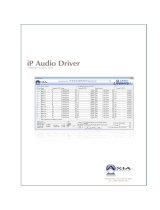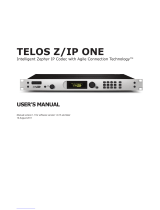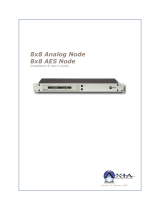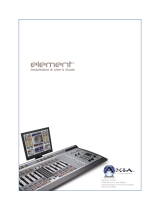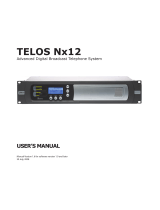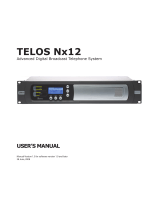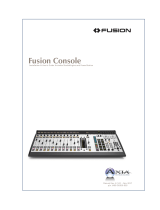Page is loading ...

TELOS iQ6
Single Studio Livewire Telco Gateway
USER’S MANUAL
Manual Version SC 1.0.2 December, 2018
TelosAlliance.com

User Warnings and Cautions
The installation and service instructions in this manual are for use by qualified personnel only.
To avoid electric shock, do not perform any servicing other than that contained in the operating
instructions unless you are qualified to do so. Refer all servicing to qualified personnel
This instrument has an autoranging line voltage input. Ensure the power voltage is within the
specified range of 100-240VAC. The ~ symbol, if used, indicates an alternating current supply.
This symbol, wherever it appears, alerts you to the presence of uninsulated, dangerous
voltage inside the enclosure – voltage which may be sufficient to constitute a risk of shock.
This symbol, wherever it appears, alerts you to important operating and maintenance
instructions. Read the manual.
CAUTION: HAZARDOUS VOLTAGES
The instrument power supply incorporates an internal fuse. Hazardous voltages may still be pres-
ent on some of the primary parts even when the fuse has blown. If fuse replacement is required,
replace fuse only with same type and value for continued protection against fire.
WARNING:
The product’s power cord is the primary disconnect device. The socket outlet should be located
near the device and easily accessible. The unit should not be located such that access to the power
cord is impaired. If the unit is incorporated into an equipment rack, an easily accessible safety
disconnect device should be included in the rack design.
To reduce the risk of electrical shock, do not expose this product to rain or moisture. This unit is
for indoor use only.
This equipment requires the free flow of air for adequate cooling. Do not block the ventilation
openings on the rear and sides of the unit. Failure to allow proper ventilation could damage the
unit or create a fire hazard. Do not place the units on a carpet, bedding, or other materials that
could interfere with any panel ventilation openings.
If the equipment is used in a manner not specified by the manufacturer, the protection provided by
the equipment may be impaired.
USA CLASS A COMPUTING DEVICE INFORMATION TO USER.
WARNING:
This equipment generates, uses, and can radiate radio-frequency energy. If it is not installed and
used as directed by this manual, it may cause interference to radio communication. This equip-
ment complies with the limits for a Class A computing device, as specified by FCC rules, part 15,
subpart j, which are designed to provide reasonable protection against such interference when
this type of equipment is operated in a commercial environment. Operation of this equipment in
a residential area is likely to cause interference. If it does, the user will be required to eliminate the
interference at the user’s expense. Note: objectionable interference to TV or radio reception can
occur if other devices are connected to this device without the use of shielded interconnect cables.
FCC rules require the use of shielded cables.

CANADA WARNING:
“This digital apparatus does not exceed the Class A limits for radio noise emissions set out in the
radio interference regulations of the Canadian department of communications.”
“Le présent appareil numérique n’émet pas de bruits radioélectriques dépassant les limites
applicables aux appareils numériques (de Class A) prescrites dans le règlement sur le brouillage
radioélectrique édicté par le ministère des communications du Canada.”
CE CONFORMANCE INFORMATION:
This device complies with the requirements of the EEC council directives:
♦ 93/68/EEC (CE MARKING)
♦ 73/23/EEC (SAFETY – LOW VOLTAGE DIRECTIVE)
♦ 89/336/EEC (ELECTROMAGNETIC COMPATIBILITY)
Conformity is declared to those standards: EN50081-1, EN50082-1.
Trademarks, Patents, and Licenses
Telos is a trademark of TLS Corp. All other trademarks are the property of their respective holders.
All versions, claims of compatibility, trademarks, etc. of hardware and software products not
made by The Telos Alliance which are mentioned in this manual or accompanying material are
informational only. The Telos Alliance makes no endorsement of any particular product for any
purpose, nor claims any responsibility for operation or accuracy. We reserve the right to make
improvements or changes in the products described in this manual which may affect the product
specifications, or to revise the manual without notice.
This document and its content are copyrighted by TLS Corporation and may not be copied,
reproduced, or distributed in any form without expressed written permission.
Patent information can be found at www.TelosAlliance.com/legal
Updates
Telos iQ6 features and operations are determined largely by software. The Telos Alliance strives
to provide the most stable and feature-rich software available. We encourage you to check for
software updates from time to time by visiting our website or by contacting us directly.
Feedback
We welcome feedback on any aspect of our products or this manual. In the past, many good ideas
from users have made their way into software revisions or new products. Please contact us with
your comments or suggestions.

We support you…
By Phone/Fax
You may reach our Telos Support Team in emergencies by calling +1 216-622-0247. For billing
questions or other non-emergency technical questions, call +1 216-241-7225 between 9:00 AM to
5:00 PM USA Eastern Time, Monday through Friday.
By Email.
Non-emergency technical support is available at Support@TelosAlliance.com.
By Web
The Telos Web site has a variety of information that may be useful for product selection and support.
The URL is https://www.telosalliance.com/Telos .
SERVICE
You must contact Telos Alliance before returning any equipment for factory service. We will need
your unit’s serial number, located on the back of the unit. We will issue a return authorization
number, which must be written on the exterior of your shipping container. Please do not include
cables or accessories unless specifically requested by the Technical Support Engineer. Be sure to
adequately insure your shipment for its replacement value. Packages without proper authorization
may be refused. US customers, please contact Telos Alliance Technical Support at +1-216-622-0247.
All other customers should contact local representative to make arrangements for service.
Warranty
For the latest Telos Alliance warranty, visit: telosalliance.com/warranty
Register your product
Register your product today to get the full benefits of our warranty, support, and product updates.
telosalliance.com/product-registration/
The Telos Alliance
1241 Superior Ave. Cleveland, OH 44114 USA
+1 (216) 241-7225
For Telos Support:
24/7 telephone: +1 (216) 622-0247
Email: [email protected]
Web: telosalliance.com/support-request

1 Introduction 1
1.1 The iQ6 . . . . . . . . . . . . . . . . . . . . . . . . . . . . . . . . . 1
1.2 Features . . . . . . . . . . . . . . . . . . . . . . . . . . . . . . . . 1
2 Installation and Configuration 3
2.1 Getting Started . . . . . . . . . . . . . . . . . . . . . . . . . . . . . 3
2.2 TELCO . . . . . . . . . . . . . . . . . . . . . . . . . . . . . . . . . . 3
2.2.1 Plain old telephone service – POTS (Analog lines) . . . . . . . . . . . 3
2.2.2 Integration with a PBX . . . . . . . . . . . . . . . . . . . . . . . 4
2.3 Basic Web Interface Conguration . . . . . . . . . . . . . . . . . . . . . 5
2.4 Client Conguration . . . . . . . . . . . . . . . . . . . . . . . . . . . 7
2.4.1 Axia iQ Surface client . . . . . . . . . . . . . . . . . . . . . . . . 7
2.4.2 VSet client . . . . . . . . . . . . . . . . . . . . . . . . . . . . . 7
2.4.3 VX Producer client . . . . . . . . . . . . . . . . . . . . . . . . . 7
3 User Operation 9
Axia iQ Console . . . . . . . . . . . . . . . . . . . . . . . . . . . . . . . 10
VSet . . . . . . . . . . . . . . . . . . . . . . . . . . . . . . . . . . . . 10
Set Talent or Producer Mode . . . . . . . . . . . . . . . . . . . . . . .10
The Line Info Field . . . . . . . . . . . . . . . . . . . . . . . . . . . . 10
Next indicator . . . . . . . . . . . . . . . . . . . . . . . . . . . . . . 11
Fader number . . . . . . . . . . . . . . . . . . . . . . . . . . . . . . 11
Line name . . . . . . . . . . . . . . . . . . . . . . . . . . . . . . .11
Caller ID . . . . . . . . . . . . . . . . . . . . . . . . . . . . . . . .11
Time . . . . . . . . . . . . . . . . . . . . . . . . . . . . . . . . . . 11
Action ‘hint’. . . . . . . . . . . . . . . . . . . . . . . . . . . . . . . 11
Line Button Columns. . . . . . . . . . . . . . . . . . . . . . . . . . . 11
Hold Button. . . . . . . . . . . . . . . . . . . . . . . . . . . . . . . 11
Drop button. . . . . . . . . . . . . . . . . . . . . . . . . . . . . . . 11
Lock . . . . . . . . . . . . . . . . . . . . . . . . . . . . . . . . . . 12
Next Button and Function . . . . . . . . . . . . . . . . . . . . . . . .12
iQ6 MANUAL | v
Table of Contents

vi |
Busy All . . . . . . . . . . . . . . . . . . . . . . . . . . . . . . . .12
Numeric Keypad. . . . . . . . . . . . . . . . . . . . . . . . . . . . . 12
Re-dial Function . . . . . . . . . . . . . . . . . . . . . . . . . . . .12
Fader Assign . . . . . . . . . . . . . . . . . . . . . . . . . . . . . .12
Take it Easy . . . . . . . . . . . . . . . . . . . . . . . . . . . . . . . 13
VX Producer . . . . . . . . . . . . . . . . . . . . . . . . . . . . . . . .13
Introduction . . . . . . . . . . . . . . . . . . . . . . . . . . . . . .13
Managing Calls . . . . . . . . . . . . . . . . . . . . . . . . . . . . . 13
Handset . . . . . . . . . . . . . . . . . . . . . . . . . . . . . . . .13
On-air . . . . . . . . . . . . . . . . . . . . . . . . . . . . . . . . . 13
Drop, Hold, and Hold Ready Buttons . . . . . . . . . . . . . . . . . . . . 14
Lock/Unlock Button and Function . . . . . . . . . . . . . . . . . . . . . 14
Fader Assign Buttons . . . . . . . . . . . . . . . . . . . . . . . . . .14
Next Button and Function . . . . . . . . . . . . . . . . . . . . . . . .15
Block All . . . . . . . . . . . . . . . . . . . . . . . . . . . . . . . . 15
Recording, Editing, and Playing Calls . . . . . . . . . . . . . . . . . . .15
Playing. . . . . . . . . . . . . . . . . . . . . . . . . . . . . . . . . 15
Editing . . . . . . . . . . . . . . . . . . . . . . . . . . . . . . . . . 16
Host/Producer Text Chatting . . . . . . . . . . . . . . . . . . . . . . .16
4 Detailed Configuration & Reference 17
4.1 Front Panel . . . . . . . . . . . . . . . . . . . . . . . . . . . . . . . 17
4.1.1 Audio Menu . . . . . . . . . . . . . . . . . . . . . . . . . . . . 18
4.1.2 Telco Menu . . . . . . . . . . . . . . . . . . . . . . . . . . . .19
4.1.3 System Menu . . . . . . . . . . . . . . . . . . . . . . . . . . .20
4.2 Web User Interface . . . . . . . . . . . . . . . . . . . . . . . . . . . . 20
4.2.1 Status. . . . . . . . . . . . . . . . . . . . . . . . . . . . . . . 21
4.2.2 Telco . . . . . . . . . . . . . . . . . . . . . . . . . . . . . . .22
4.2.3 Audio . . . . . . . . . . . . . . . . . . . . . . . . . . . . . . . 24
4.2.4 Show Setup . . . . . . . . . . . . . . . . . . . . . . . . . . . . 26
4.2.5 Livewire Audio . . . . . . . . . . . . . . . . . . . . . . . . . . . 28
4.2.6 Livewire GPIO . . . . . . . . . . . . . . . . . . . . . . . . . . .28
4.2.7 Livewire QoS . . . . . . . . . . . . . . . . . . . . . . . . . . . . 29
4.2.8 System . . . . . . . . . . . . . . . . . . . . . . . . . . . . . .29

iQ6 MANUAL | vii
4.2.9 Backup . . . . . . . . . . . . . . . . . . . . . . . . . . . . . . 31
5 Technical Data & Troubleshooting 33
5.1 Overview . . . . . . . . . . . . . . . . . . . . . . . . . . . . . . . . 33
5.2 System Software & Firmware . . . . . . . . . . . . . . . . . . . . . . . 33
Viewing Version Information . . . . . . . . . . . . . . . . . . . . . . . 33
5.3 General Troubleshooting . . . . . . . . . . . . . . . . . . . . . . . . . 34
Thinking about Problem Solving . . . . . . . . . . . . . . . . . . . . .34
A Final Thought… . . . . . . . . . . . . . . . . . . . . . . . . . . .35
5.4 Replaceable Modules and Hardware Servicing . . . . . . . . . . . . . . .35
Replaceable modules . . . . . . . . . . . . . . . . . . . . . . . . . .35
Fuse Replacement . . . . . . . . . . . . . . . . . . . . . . . . . . . . 35
Access to the Main PCB . . . . . . . . . . . . . . . . . . . . . . . . . . 35
5.5 Livewire Audio Troubleshooting . . . . . . . . . . . . . . . . . . . . . . 36
6 Specications 39
General . . . . . . . . . . . . . . . . . . . . . . . . . . . . . . . . . .39
Processing Functions . . . . . . . . . . . . . . . . . . . . . . . . . . . .39
General. . . . . . . . . . . . . . . . . . . . . . . . . . . . . . . . . 39
Send (to caller) Processing . . . . . . . . . . . . . . . . . . . . . . . . 39
Receive (from caller) Processing . . . . . . . . . . . . . . . . . . . . . . 39
Audio . . . . . . . . . . . . . . . . . . . . . . . . . . . . . . . . . . .40
Livewire . . . . . . . . . . . . . . . . . . . . . . . . . . . . . . . .40
Switching Matrix and Conferencing . . . . . . . . . . . . . . . . . . . . . . 40
Analog Telephone Line Connectivity . . . . . . . . . . . . . . . . . . . . . . 40
Control Ports . . . . . . . . . . . . . . . . . . . . . . . . . . . . . . . . 40
Ethernet 100Base-T . . . . . . . . . . . . . . . . . . . . . . . . . . . 40
7 Telos Alliance Warranty 41

BLANK PAGE

Creating the Most Exciting and Engaging
Audio Experiences Imaginable
Congratulations on your new Telos Alliance product!
The gang here at Telos is committed to shaping the future of audio by delivering innovative, intuitive
solutions that inspire our customers to create the most exciting and engaging audio experiences imaginable.
We’re grateful that you have chosen audio tools from Telos® Systems, Omnia® Audio, Axia® Audio,
Linear Acoustic®, 25-Seven Systems®, and Minnetonka Audio®. We’re here to help you make your
work truly shine. We hope that you enjoy your Telos Alliance product for many years to come and won’t
hesitate to let us know if we can help in any way.
The Telos Alliance

BLANK PAGE

| 1
1
Introduction
1.1 The iQ6
The Telos iQ6 is the Telco gateway for Axia’s iQ console. iQ6 combines a six line selector
and two third-generation Telos hybrids with Digital Dynamic EQ. The two hybrids are
designed to be used within a single studio for airing simultaneous callers and achieving
optimal audio quality.
Control the iQ6 from the Axia iQ console equipped with the Telco expansion frame via a pro-
ducer’s PC running the VX Producer software. Take and screen calls directly via the producer’s
PC that uses the VX Producer software. All controllers function with a TCP connection and the
iQ6 provides support for twelve connections.
The iQ6 comes with a POTS interface. This provides support for the connection of six lines for
the two integrated hybrids.
Audio input and output is accomplished through Livewire for seamless integration to the Axia
iQ console. There are no dedicated connectors on the back panel for audio. All control and audio
passes through the Ethernet Adapter and the CAT-5e cable which connects to it.
1.2 Features
Telos introduced the first digital hybrid which increased the quality of caller audio. Over the
years, each new Telos product continues to raise the bar. The iQ6 is no exception.
♦ Third generation advanced hybrid algorithms.
♦ New symmetrical wide-range AGC and noise gate by Omnia, with adjustable gain
settings.
♦ Adjustable caller override improves performance and allows you to customize the degree
to which the announcer ducks the caller audio.
♦ DDEQ-Digital dynamic EQ™ keeps audio spectrally consistent from call to call.
♦ Separate Send level and Receive level meters for each hybrid.
♦ Worldwide disconnect signal detection (loop drop, dial tone, or reorder tone).
♦ Livewire Audio.
♦ Axia iQ console integration.
♦ Conference linking lets you set up high-quality conferencing between callers with no
external equipment needed.
♦ Caller ID support on POTS lines.
♦ Support for up to twelve controllers.
VX control protocol for compatibility with Telos VSet, VX Producer, and third-party call
control software applications.

BLANK PAGE

| 3
2
Installation and Configuration
2.1 Getting Started
The iQ6 mounts in a 1RU high space in a standard 19” rack. There are ventilation holes to the side and top.
Do not restrict the ventilation holes. Find a suitable location that will provide air movement and access to
the front and rear of the iQ6.
Connect the Telco circuits (section 2.2)
Connect power, and once the Telos iQ6 flash screen appears, configure the IP address of the iQ6. Press any
of the three keys to access the configuration options.
Press the down arrow key to highlight System, press (OK)
Press to highlight Networking, press (OK)
Press to highlight IP address, press (OK)
Use to delete and move the curser back. Once you press , you begin to enter a value at curser position,
starting with 0. Use and to select the desired value, then press (OK). Once the value is complete, press
(OK) once more.
The remainder of the necessary configuration will occur with a PC’s web interface. Use a direct connection
between a PC and the iQ6 with the use of a cross over cable or a normal patch cable to your LAN (local area
network). Connect the required cable to the Livewire port. The PC should have an IP address that is within
the same subnet as the iQ6. (section 2.3)
Configure VSets, VX Producer software, and Axia iQ console to function with the iQ6. (section 2.4)
2.2 TELCO
The iQ6 has one slot for a POTS Telco interface module, supporting up to six lines. There are three subsec-
tions to the Telco installation. They are:
♦ 2.2.1 Plain old telephone service – POTS
♦ 2.2.2 Integration with a PBX (private telephone system)
2.2.1 Plain old telephone service – POTS (Analog lines)
The iQ6 uses a plug-in interface module to attach to POTS (regular, analog loop start, telephone lines). The
country setting is accessed from the front display. The default country is USA.
From the Status screen, press any of the three keys to access the configuration options.
Press the down arrow key to highlight Telecom, press (OK)
Press to highlight POTS, press (OK)
Press to highlight Country, press (OK)
Use and to select your country, press (OK). If you do not see your country listed
you should use CTR21 or USA.

4 | Section 2
The module has six modular jacks. The type of jack will be a six position four pin RJ-11 style. The connec-
tion is to the center two pins of this jack. Note: Unlike our older products, the iQ6 does not have the loop
through provision for POTS lines. The POTS lines used with the iQ6 should be dedicated. The yellow and
black leads (pins 2 and 5) of the modular connectors should be disconnected and insulated.
IMPORTANT
When we say POTS lines, we mean just that – plain old analog loop start telephone lines. A rule
of thumb – if a line works with an analog modem or fax machine, it will work with the iQ6.
Analog Ground Start lines can be used for incoming calls only. However you will need to set
the “Loop Check” option in the Telco menu to “No” for these lines to be recognized properly.
Be careful not to connect the iQ6 to PBX ports intended for proprietary telephones. These
sometimes have voltages that could damage the iQ6.
2.2.2 Integration with a PBX
The iQ6 will usually be used independently of any other phone system in your facility. But it is possible to
have one or more of the lines come from another phone system.
Consider having at least one line directly from the Telco to keep your iQ6 up and running even if the PBX or
its Telco connection goes down.
Using POTS through PBX
Most PBX or VoIP telephone systems can provide analog ports for analog equipment such as modems and
fax machines. You will need such ports to connect a POTS iQ6 to a PBX.
A few years ago, we advised that hybrid performance was best when equipment was connected directly
to the lines from the Telco. Today, this is not always true. If the PBX is connected to the Telco using digital
lines (such as T1, E1, PRI, S2M, etc), performance through a digital PBX will generally be better than direct
connections to copper analog circuits. This is particularly so if you are located a significant distance from
the Telco central office.
The biggest variable when connecting to a PBX analog port is the quality of the analog port. We have
found that many PBX manufacturers offer more than one analog port option. The better port can usually
be distinguished by its higher cost, and the fact that it may offer 48 volts rather than 24 volts. The iQ6 will
work with either voltage; however experience has shown that the 48-volt version usually has better quality
transformers and other components, resulting in better hybrid performance.
The other thing to investigate is whether the PBX offers ‘Loop Current Wink’ or ‘CPC’ (Calling Party
Control) on the analog ports. Without this supervision, the iQ6 will not detect that a caller on hold has
hung up, and your talent will get a recording “please hang up and dial again…” or dial tone when attempting
to air such calls.

INSTALLATION AND CONFIGURATION | 5
2.3 Basic Web Interface Conguration
Some basic settings need to be entered into the web interface before you can really do anything with the
iQ6. With a PC that is connected directly to the iQ6 with a cross over cable, or connected through a LAN
and with the correct network settings, open a web browser application and in the address field, type the IP
address which you have assigned to the iQ6.
The Home screen is shown above. First select the Livewire Configuration link. Username is user and the
password should be left blank.
Assign the desired Livewire Channel number in the Channel field so that the iQ6 will produce audio and
send it to the appropriate unique channel. You can also assign the Livewire channel for the Program On
Hold (POH) source, if you have one. Once the correct values are in place, press the Apply button and
continue to the Telco configuration.

6 | Section 2
From the Telco page, you have the option to configure the POTS interface.
POTS Interface
Verify the correct country setting is selected and any of the other desired settings. For reference on the other
settings, refer to the detailed configuration section.

INSTALLATION AND CONFIGURATION | 7
2.4 Client Conguration
There are three different clients which can connect to the iQ6. The client limit connection is twelve.
♦ Axia iQ surface (2.4.1)
♦ VSet (2.4.2)
♦ VX Producer (2.4.3)
2.4.1 Axia iQ Surface client
For details on the Axia iQ console, please refer to the appropriate documentation for the product. This
section is here to assist with interfacing iQ6 to your iQ console.
Connect to the iQ console’s web interface and select a Show Profile. The Show Profile page has Phone
Connection settings to be filled in.
♦ Phone Server IP: Enter in the user name, password, and IP address of the iQ6 in the following format:
♦ User: [email protected] (telos@192.168.2.106)
♦ Studio Name: Enter “Hybrid 1&2”
♦ Show Name: This is used for TelosVX systems and may be left blank
Save your Show Profile and reload it using the Profile key on the console. When the show is loaded, the iQ
will log into the iQ6 as a client.
2.4.2 VSet client
For details on the VSet, please refer to the appropriate documentation for the product.
To set up your VSet for use with iQ6, follow these steps:
♦ Press the Setup softkey
♦ Select the VX Engine IP soft key
♦ Enter in User, Password, and IP address
♦ The VSet will log into the iQ6 as a client
2.4.3 VX Producer client
For details on the VX Producer, please refer to the appropriate documentation for the product.
If VX Producer is not connected to a server, options will be available at the top page that need to be filled in.
♦ VX Engine IP: enter the IP address of the iQ6.
♦ Port: defaults to 20518 and should be maintained.
♦ Username: can be left blank
♦ Password: can be left blank
VX Producer will log into the iQ6 as a client and show the active studio. There is only one studio associated
with the iQ6. Select the “Hybrid 1&2” Studio.
VX Producer is now connected to the iQ6

BLANK PAGE

| 9
3
User Operation
Telco lines used with your iQ6 can be in many different states, simultaneously. The iQ6 has a front panel
OLED display which will show the status of the lines. Also, the web interface on the Status page gives
remote access to these same states. The three different clients, Axia iQ console, VSet, and VX Producer, will
also show the states of these lines. The following symbols define the states.
Line is ready for incoming or outgoing calls
(you may be able to observe a small pulse occur with this symbol)
Line is ringing
Call is on hold
Call is ON AIR – Hybrid 1
Call is ON AIR – Hybrid 2
Call is ON AIR & Locked – Hybrid 1
Call is ON AIR & Locked – Hybrid 2
Screened Hold – Call is on hold and has been screened by Producer
Block All Mode (busy lines)

10 | Section 3
Call is in progress (either with VX Producer or VSet)
iQ6 can be controlled by using either the VSet phone, VX Producer software, or the phone controls built
into your iQ console’s Telco frame. Let’s look at each of those controllers.
Axia iQ Console
The Axia iQ console Telco expansion module is designed to interface with the iQ6.
Its basic controls are as follows.
♦ Keypad: Used for placing outbound phone calls
♦ Transfer: Used to create a “hook flash” in POTS analog phone systems. Depending on the way you’ve
ordered your Telco service, this key may serve to activate features such as transfer or 3-Way Calling.
♦ Block All: Pressing this key once will “busy” all phone lines (except those that are on-air, on hold, or
on a handset), thus blocking incoming calls. Pressing the key a second time will release call blocking.
♦ Line Buttons: Each line has 2 buttons, the left column for Hybrid 1 and the right column for Hybrid
2. Pressing a line button places the caller on that line on-air using the corresponding hybrid. Pressing
a line button when a call is already on-air locks the call on-air, preventing accidental disconnection.
To unlock, press the line button a third time.
♦ Drop 1 and 2 Buttons: These buttons will drop calls (in their respective column) that are currently
on-air, if that call is not in the “locked” state described above.
♦ Next: Selects the line which has been ringing longest. If no line is ringing, it selects the line that has
been on (normal) hold the longest.
VSet
Set Talent or Producer Mode
The VSet should be set to Talent mode when it is located in the studio and is used to put calls on the air.
Producer mode is for a VSet that is being used by a producer to screen calls. In Producer mode, calls cannot
be put on-air and on-air calls cannot be dropped. The function of the right line button column is different in
the two modes to serve the needs of each type of operator, as described below.
Press the menu button to access the menu functions. The LCD will show the various items that can be
changed. Select Talent or Producer and then exit the menu functions by pressing the menu button.
The Line Info Field
Each line has a corresponding portion of the LCD display to the right of the line button that shows status
and info about that line.
/
